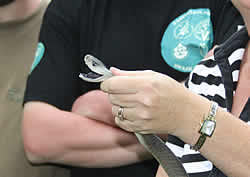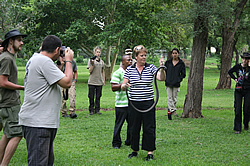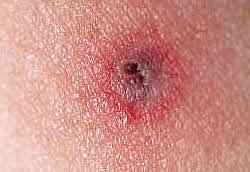(PDF). Atovaquone/proguanil (Malarone)
is a recently approved combination pill taken once daily with
food starting two days before arrival and continuing through
the trip and for seven days after departure.
Side-effects,
which are typically mild, may include abdominal pain, nausea,
vomiting, headache, diarrhea, or dizziness. Serious adverse
reactions are rare.
Doxycycline
is effective, but
may cause an exaggerated sunburn reaction,
which limits
its usefulness in the tropics
Travelers who will be visiting remote areas in Mozambique
for an extended time and as a result may not have easy access
to medical care, should bring along medications for emergency
self-treatment should they develop symptoms of
malaria.
Symptoms such as fever, chills, headaches, and
muscle aches, should be considered as an indication of
malaria.
Malaria symptoms can sometimes not occur for
months or even years after exposure.
HIV / AIDS - CLICK HERE FOR MORE DETAILS ON HIV / AIDS
HIV / AIDS is a major danger in Southern Africa and responsible precautions are of major importance, when indulging in sexual practices with strange partners.
From : www.avert.org/aids-swaziland.htm
"In eSwatini (Swaziland), a small landlocked country in Southern Africa, one in four adults are living with HIV. Since the first cases of AIDS were reported in the country in 1986, the virus has spread at an alarming rate and now eSwatini (Swaziland) has the highest HIV prevalence in the world.
Women have been particularly affected by the epidemic; among those aged 15-49 HIV prevalence is 31% among women, compared to 20% among men
AIDS has devastated the country. Orphans and vulnerable children account for an estimated 15 percent of the total population
In 2009 around 7,000 adults and children died from AIDS.The impact of eSwatini (Swaziland)'s epidemic has been so severe that life expectancy has dropped to just 32 years - the lowest in the world. The long-term survival of eSwatini (Swaziland) as a country will be seriously threatened if the spread of HIV is not halted
SNAKEBITE
Please view www.antivenomswazi.org for excellent info about eSwatini (Swaziland) and snakes
There are
The vast majority of snakes in eSwatini (Swaziland) are harmless : 83 different species of which only 7 are poisonous. and even the poisonous ones are more afraid of you than you of them!
However, venomous snakes need to be treated with respect, particularly the Black Mamba, Spitting Cobra, Snouted Cobra, Puff Adder and Boomslang.
Other snakes commonly found in eSwatini (Swaziland) include the non-venomous African Rock Python, Spotted Bush snake, the mildly venomous Olive Whip Snake, Tiger Snake and Brown House Snake.
Although t he chances of encountering a venomous snake are very slim, sensible precautions should be taken such as wearing boots or lace up shoes when hiking or walking in bush or grass. In the event of encountering a snake, just stand absolutely still. Snakes will bite only if provoked, as they can not see distant detail, but have excellent perception of movement.
- When a snake has entered a home or office, call someone qualified to remove the snake unless you are positive that it is harmless, or you know how to catch snakes.
- Teach young children to stay away from snakes
- In case of a bite, get a good description of the snake to identify whether it was harmless or not
- Look for help
- Wash the wound
- Elevate the limb (not for Mamba bite)
- Do not use a tourniquet (unless the snake was definitely a Mamba!)
- Do not cut or burn the wound
- Cobras can spit venom into eyes. Irrigate the eyes with water as soon as possible
- Snakebite needs observation in hospital. Anti-venom is used in about 1 in 10 cases of venomous snake bite
- Anti-venom is the only specific cure for a lethal dose of snake poison.
- Antivenom. is expensive and needs refrigeration and therefore most rural clinics do not keep anti-venom stock. When indicated, it should be administered very carefully.
For snake identification and advice on removal of snakes, Thea Litschka is most helpful. (00268- 7602 5088). She also stocks anti-venom. For the ultimate snake experience, you could do a snake handling course!Read more |
Mozambique Spitting Cobra

Black Mamba

Thea Litschka

|
TICK BITE FEVER
- Tick bite fever is a bacterial infection transmitted by ticks.
- Symptoms of tick bite fever may include fever, headache, malaise and a skin rash.
- Being bitten by ticks usually occurs during outdoor activities in rural or wilderness areas.
- The symptoms of tick bite fever can vary considerably in severity.
- Tick bite fever can be treated with antibiotics such as doxycycline.
The organism that causes tick bite fever belongs to the Rickettsial family of bacteria. These organisms are relatively small – about 2/1000ths of a millimetre long – and are only able to survive inside cells. They are found in certain wild and domestic animals, and ticks acquire the organisms when they feed on these animals.
When the tick bites a human, the bacterium is transmitted in the saliva. The bacteria can also be transmitted from ticks to their offspring when still in the egg stage i.e. the Rickettsiae infect the eggs of the tick and thus infect the offspring. If you get bitten by an infected tick, the incubation period (the period between being infected and displaying symptoms) is about five to seven days.
SYMPTOMS
Typical features may include the presence of a black mark where the bite occurred, and fever, severe headache and a rash. The black mark at the site of the tick bite is called an eschar (or a tache noir), and looks like a small ulcer (2-5mm in diameter) with a black centre. It may look something like a spider bite. The eschars can be single or multiple and can sometimes be very difficult to find. The eschar usually appears once the fever appears, as does the headache and malaise (general feeling of ill-health). Lymph nodes near the eschar may be enlarged.
A rash is usually, but not always, a feature of tick bite fever (it is supposedly less likely to occur in someone infected by R. africae), but when it is present, it consists of small red marks on the skin, sometimes raised slightly above the surface. It typically starts on the limbs and spreads to the trunk, and can involve the entire body, including the palms of the hands and soles of the feet.
TREATMENT
Some forms of tick bite fever are fairly mild and self-limiting – people may get better on their own without specific treatment. This can take up to two weeks however, and treatment with an antibiotic can shorten the duration of symptoms and reduce the chance of a serious side-effect. In severe cases, antibiotic therapy is more important, and can be life saving. The antibiotic doxycycline is the preferred agent for treating tick bite fever. Some people are not able to take doxcycline, in which case chloramphenicol, or sometimes ciprofloxacin, may be used instead.
Experience with using ciprofloxacin is more limited than with doxycycline or chloramphenicol. In addition, the use of antibiotics like clarithromycin and azithromycin for treating tick bite fever is being studied. These agents may be especially useful for treating pregnant women with tick bite fever.
www.health24.com |

Eschar

|
CURRENCY
- Lilangeni (singular) or Emalangeni (plural) and cents are the currency of eSwatini (Swaziland).
- It is equal in value to the South African Rand and cents and both currencies are in circulation.
- All businesses accept all South African notes - except , currently, the the 200 Rand note due to the many counterfeit R200 notes in circulation in eSwatini (Swaziland).
- Usually businesses are loathe to accept the smaller South African coinsother then R1 , R2 and R5.
- The traveler is advised to change Emalangeni back to his own currency before leaving eSwatini (Swaziland) as Emalangeni will not be accepted in South Africa.
- There is no currency controls at border posts and no limit to the amount of currency a traveler may carry.
- All acceptable credit cards and travelers cheques are honoured in eSwatini (Swaziland).
|

